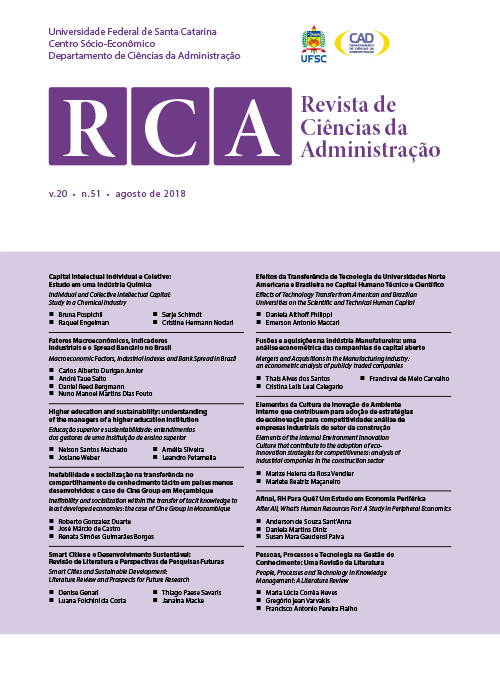Fatores macroeconômicos, indicadores industriais e o spread bancário no Brasil
DOI:
https://doi.org/10.5007/2175-8077.2018v20n51p26Resumo
O objetivo deste trabalho é Identificar os fatores macroeconômicos e os indicadores industriais que influenciaram o spread bancário brasileiro no período de Março de 2011 a Março de 2015. É considerada a subclassificação de alguns segmentos de atividade industrial. Foram utilizados dados mensais de séries temporais em modelos de regressão linear multivariada com uso do Eviews (7.0), dezoito variáveis foram consideradas como possíveis determinantes.. Influenciam positivamente; a inadimplência, os IPIs (Índices de Produção Industrial) de bens de capital, bens intermediários, bens de consumo duráveis, bens semiduráveis e não duráveis, a Selic, o PIB, a taxa de desemprego e o EMBI+. Determinam negativamente; os IPIs bens de consumo e geral, IPCA, o saldo da carteira de crédito e o índice de vendas no varejo. Foi considerado p-valor de 05%.. A conclusão principal é que o progresso da indústria, da geração de empregos e do consumo podem reduzir o spread.
Downloads
Publicado
Como Citar
Edição
Seção
Licença
O autor deve garantir:
- que haja um consenso completo de todos os coautores em aprovar a versão final do documento e sua submissão para publicação.
- que seu trabalho é original, e se o trabalho e/ou palavras de outras pessoas foram utilizados, estas foram devidamente reconhecidas.
Plágio em todas as suas formas constituem um comportamento antiético de publicação e é inaceitável. RCA reserva-se o direito de usar software ou quaisquer outros métodos de detecção de plágio.
Todas as submissões recebidas para avaliação na revista RCA passam por identificação de plágio e autoplágio. Plágios identificados em manuscritos durante o processo de avaliação acarretarão no arquivamento da submissão. No caso de identificação de plágio em um manuscrito publicado na revista, o Editor Chefe conduzirá uma investigação preliminar e, caso necessário, fará a retratação.
Os autores cedem à RCA os direitos exclusivos de primeira publicação, com o trabalho simultaneamente licenciado sob a Licença Creative Commons (CC BY) 4.0 Internacional.

Os autores têm autorização para assumir contratos adicionais separadamente, para distribuição não exclusiva da versão do trabalho publicada neste periódico (ex.: publicar em repositório institucional, em site pessoal, publicar uma tradução, ou como capítulo de livro), com reconhecimento de autoria e publicação inicial neste periódico.
Esta licença permite que qualquer usuário tenha direito de:
Compartilhar – copiar, baixar, imprimir ou redistribuir o material em qualquer suporte ou formato.
Adaptar – remixar, transformar e criar a partir do material para qualquer fim, mesmo que comercial.
De acordo com os seguintes termos:
Atribuição – Você deve dar o crédito apropriado (citar e referenciar), prover um link para a licença e indicar se mudanças foram feitas. Você deve fazê-lo em qualquer circunstância razoável, mas de maneira alguma que sugira ao licenciante apoiar você ou o seu uso.
Sem restrições adicionais – Você não pode aplicar termos jurídicos ou medidas de caráter tecnológico que restrinjam legalmente outros de fazerem algo que a licença permita.


